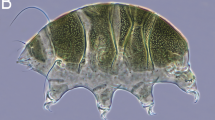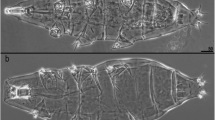Abstract
During the “Workshop on Arctic tardigrades” at the Danish Arctic Station (Qeqertarsuaq, Disko Island, Greenland) an undescribed species of Dactylobiotus was found in freshwater sediments of the Isunngua spring. We have the honour and pleasure to describe this new taxon that we dedicate to all participants of that symposium, naming the species Dactylobiotus octavi sp. n. The animals appear similar to Dactylobiotus dispar and Dactylobiotus haplonyx with the presence of a very short secondary branch in the claws of the first three pairs of legs, but they differ from these species in the size of claw and buccal tube width. This new species also has peculiar ornamented eggs. The eggshell consists of bowl-like processes, each one surrounded by a band of fine pores. A morphological parsimony analysis to identify phylogenetic relationships among D. octavi sp. n. and the other Dactylobiotus species was performed, obtaining inconclusive results. The discovery of this new species increases an unsolved paradox in tardigrade systematics related to the presence of closely related species which share a very similar morphology of the animals but clearly differ in their egg morphology, while, conversely, there are species belonging to different evolutionary lines that have similar eggs, but very different adult morphology. The finding of D. octavi sp. n. increases the already high number of species found in Disko Island and once again underlines the importance of tardigrades in the biodiversity of the Arctic area.
Similar content being viewed by others
References
R. Bertolani (1982a) ArticleTitleA new genus and five new species of Italian fresh-water tardigrades Bollettino del Museo Civico di Storia Naturale di Verona 8 249–254
Bertolani, R., 1982b. Tardigradi (Tardigrada). Guide per il riconoscimento delle specie animali delle acque interne italiane. Quaderni C.N.R., AQ/1/168 15: 1–104
M. G. Binda G. Pilato (1999) ArticleTitleDactylobiotus lombardoi sp. n. (Eutardigradi: Macrobiotidae) from Tierra del Fuego, with a key to the Dactylobiotus-species Zoologischer Anzeiger 238 147–155
V. I. Biserov (1998) ArticleTitleThe Tardigrada of the Komandorskiye Islands, with a description of Dactylobiotus dervizi sp. n. (Eutardigrada, Macrobiotidae) Entomologische Mitteilungen aus dem Zoologischen Museum Hamburg 12 327–336
R. Guidetti A. Gandolfi V. Rossi R. Bertolani (2005) ArticleTitlePhylogenetic analysis in Macrobiotidae (Eutardigrada, Parachela): a combined morphological and molecular approach Zoologica Scripta 34 235–244 Occurrence Handle10.1111/j.1463-6409.2005.00193.x
H. S. Heide-Jorgensen R. M. Kristensen (1998) Puilassoq, Disko øens varmeste homoterme kilde Arctic Biology Course Disko Island Greenland 219–231
H. S. Heide-Jorgensen R. M. Kristensen (1999) ArticleTitlePuilassoq, the warmest homothermal spring of Disko Island Berichte zur Polarforschung 99 32–43
R. M. Kristensen (1987) The “Southern” Flora and the “Marine” Fauna Elements in the Homothermic Springs on Disko Island, West Greenland. Grönland Excursion Institut für polarökologie Kiel 202–226
R. M. Kristensen P. Funch (2000) ArticleTitleMicrognathozoa: a new class with complicated jaws like those of Rotifera and Gnathostomulida Journal of Morphology 246 1–49 Occurrence Handle11015715 Occurrence Handle1:STN:280:DC%2BD3M%2FjtFersg%3D%3D
A. Jørgensen R. M. Kristensen (2004) ArticleTitleMolecular phylogeny of Tardigrada – investigation of the monophyly of Heterotardigrada Molecular Phylogenetics and Evolution 32 666–670 Occurrence Handle15223045
W. Maucci (1980) ArticleTitleDactylobiotus haplonyx sp. nov., nuova specie di tardigrado della fauna interstiziale dei fiumi padani Bollettino del Museo Civico di Storia Naturale di Verona 7 495–499
G. Pilato (1981) ArticleTitleAnalisi di nuovi caratteri nello studio degli eutardigradi Animalia 8 51–57
G. Pilato M. G. Binda (1994) ArticleTitleDactylobiotus caldarellai, nuova specie di eutardigrado della Terra del Fuoco Animalia 21 IssueID1/3 87–91
G. Ramazzotti W. Maucci (1983) ArticleTitleIl Phylum Tardigrada. Terza edizione riveduta e corretta Memorie dell’Istituto Italiano di Idrobiologia Dott. Marco De Marchi 41 1–1012
R. O. Schuster E. C. Tofner A. A. Grigarick (1977) ArticleTitleTardigrada of Pope Beach, Lake Tahoe, California The Wasmann Journal of Biology 35 IssueID1 115–136
D. L. Swofford (2003) PAUP – Phylogenetic Analysis Using Parsimony. Ver. 4.0 [Computer Software and Manual] Sinauer Associates Massachusetts, Sunderland
G. Thulin (1911) ArticleTitleBeiträge zur Kenntniss der Tardigradenfauna Schwedens Arkiv för Zoologi 7 1–60
Author information
Authors and Affiliations
Rights and permissions
About this article
Cite this article
Guidetti, R., Altiero, T. & Hansen, J.G. A New Species of Freshwater Tardigrades from Disko Island (Greenland) Increases an Unsolved Paradox in Tardigrade Systematics. Hydrobiologia 558, 69–79 (2006). https://doi.org/10.1007/s10750-005-1408-6
Issue Date:
DOI: https://doi.org/10.1007/s10750-005-1408-6




